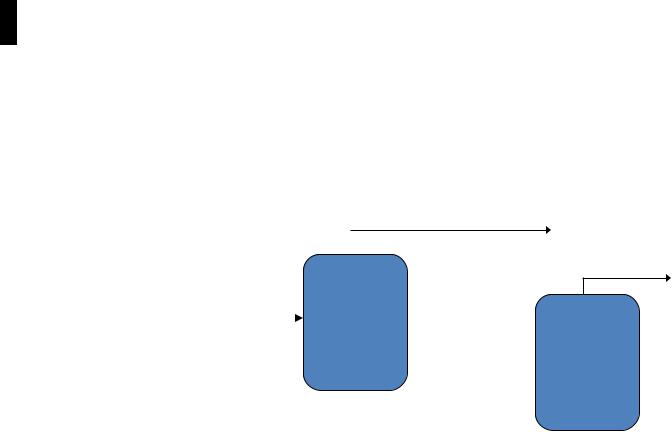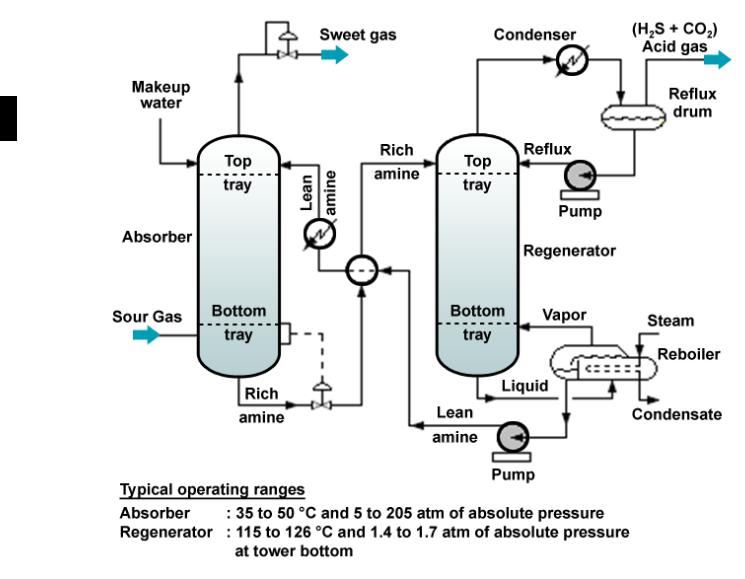
Chapter_7-OCW
.pdf
Gas Treating
Natural gas consists of various components which are present in different concentration (water and impurities).
 Reason for treating:
Reason for treating:
To meet sales specifications and customer's requirement.
To recover other materials such as CO2 and elemental sulfur from H2S (higher price if marketed separately.
To facilitate transmission - prevent hydrate formation.

Gas Sweetening Process
Gas Sweetening is the most common gas treating process.
 Also known as amine gas treating or acid gas removal.
Also known as amine gas treating or acid gas removal.
The process consist two main unit: absorber and regenerator.
 In the absorber, amine solution absorbs H2S and CO2 from the upflowing sour gas to produce a sweetened gas stream (i.e., an H2S-free gas) as as a product and an amine solution rich in the absorbed acid gases.
In the absorber, amine solution absorbs H2S and CO2 from the upflowing sour gas to produce a sweetened gas stream (i.e., an H2S-free gas) as as a product and an amine solution rich in the absorbed acid gases.
 The resultant "rich" amine is then routed into the regenerator (a stripper with a reboiler) to produce regenerated or "lean" amine that is recycled for reuse in the absorber.
The resultant "rich" amine is then routed into the regenerator (a stripper with a reboiler) to produce regenerated or "lean" amine that is recycled for reuse in the absorber.

Gas Sweetening Process
 The sweet gas normally goes on to additional processing such as dehydration and hydrocarbon recovery.
The sweet gas normally goes on to additional processing such as dehydration and hydrocarbon recovery.
 The acid gas contains most of the CO2 and sulfur compounds is either flared or sent to a Claus sulfur recovery unit
The acid gas contains most of the CO2 and sulfur compounds is either flared or sent to a Claus sulfur recovery unit
|
|
|
|
|
|
|
|
|
Sweet |
|
||
|
|
|
|
|
|
|
|
|
|
|||
|
|
|
|
|
|
|
|
|||||
|
|
|
|
|
|
|
|
|||||
|
|
|
|
|
|
|
|
|
|
|||
|
|
|
C1-C4 |
|
|
Residue Gas |
|
|||||
|
|
|
|
|||||||||
|
|
|
|
|
|
|||||||
|
|
|
N |
|
|
|
|
|
|
|
|
|
|
|
|
H22S |
|
|
Sour |
|
|
|
|||
|
|
|
|
|
|
|||||||
|
|
|
COS |
|
Gas |
|
|
|||||
|
|
|
CO2 |
|
(Carbonylsulfide) |
|
|
|||||
|
|
|
|
|
||||||||
|
|
|
CS2 |
|
|
|||||||
|
|
|
(Carbon Disulfide) |
|
|
|
||||||
|
|
|
RSR (Mercaptans) |
|
|
|
|
|
|
|||
C1-C4 N2 H2O
Acid GasH2S
CO2
COS
CS2
RSR
H2O

Gas Sweetening Process
